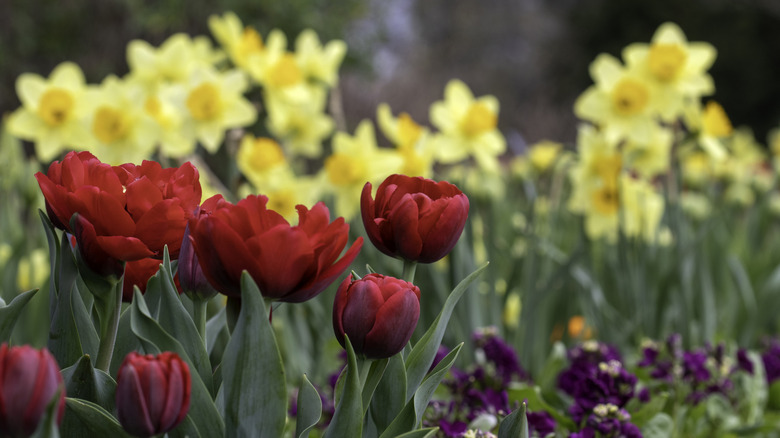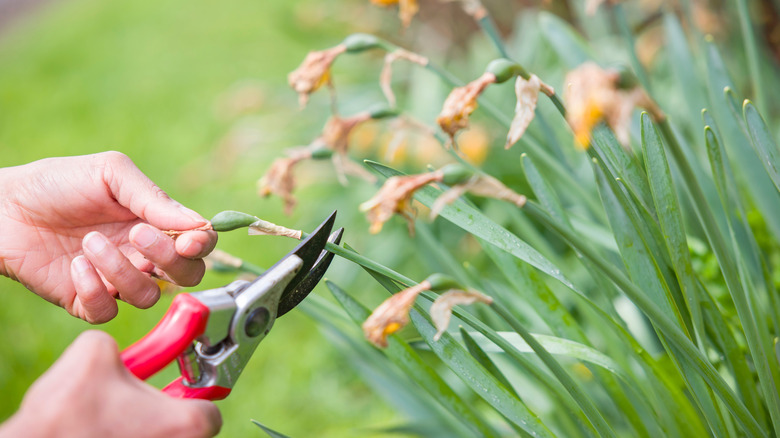Grow Even Bigger Bulbs Next Spring With These Essential Pruning Tips
Flowering bulbs in bloom look great — until they don't. Once the bloom is off the rose, as they say — or in this case, the daffodil, tulip, or other flowering bulb — you might be tempted to tidy up your garden by cutting back the leaves or tying them together. But remember your grade-school botany and encourage your flowers to do what comes naturally: photosynthesize sunlight. That's how they store atmospheric carbon dioxide in their bulbs as sugars, which allows them the energy to regrow the following year. To encourage the growth of bigger bulbs, you should deadhead the flowers once they're done blooming, but only prune the leaves once they've died back and are no longer green.
However, not every flowering bulb needs deadheading or pruning. Cutting leaves back at the base can prevent the accumulation of disease, but it is often done merely for aesthetic reasons. Deadheading depends on how the plant reproduces. Snowdrops, bluebells, grape hyacinths (muscari), and squill will naturalize in your garden from their seeds, so deadheading their spent flowers will inhibit new growth. Hyacinths, daffodils, tulips, and lilies, however, don't naturalize well from seed, so deadheading is advisable.
It takes a lot of energy to produce flowers, and a flower's bulb is its energy storage device, so bigger bulbs increase the likelihood of the plant producing the flowers you expect. To give your bulbs an energy boost beyond sunlight and deadheading, fertilize them in the fall and early spring, just after their shoots emerge. The best method for fertilizing tulips and other bulbs is to add some natural plant food, such as compost and a slow-release fertilizer, to help the regeneration process.
When deadheading is advised
Generally speaking, plants aren't great at multitasking: when they're producing flowers, they're not growing roots, stems, or leaves. For those flowering bulbs for which deadheading is a must, removing dead flowers prevents the plant from producing seeds, which is energy that could be better used by storing it in the bulb. Trying to grow many bulb plants from seeds is a slow and not always successful process, so your efforts are better spent on maintaining a healthy bulb. By deadheading your plants after they are done blooming, you may even get the added benefit of a second bloom later in the year. When pruning or deadheading, use sharp garden shears and make sure to clean and disinfect them to prevent the spread of disease.
Commercially grown bulbs are often hybridized to produce their maximum bloom their first year, but they tend to last only a few years. If you plant botanical species (rather than hybrids) or hybrids that are bred for naturalizing, you're more likely to have longer-lasting flowers and a second bloom after deadheading. Better yet, try planting bulbs native to your region, like some flowering onions (such as Allium schubertiior Allium amplectens) or quamash (Camassia spp.). Native bulbs are better adapted to their climate and have an easier time surviving the local changes of season.
Flower bulbs are tiny carbon sinks in the soil. Not only are your bulbs reducing the amount of carbon in the atmosphere, but by growing bigger bulbs and encouraging their longevity, you are reducing your need to replace them every year, lowering the amount of carbon emissions needed to produce and ship new bulbs, which often come from overseas.

